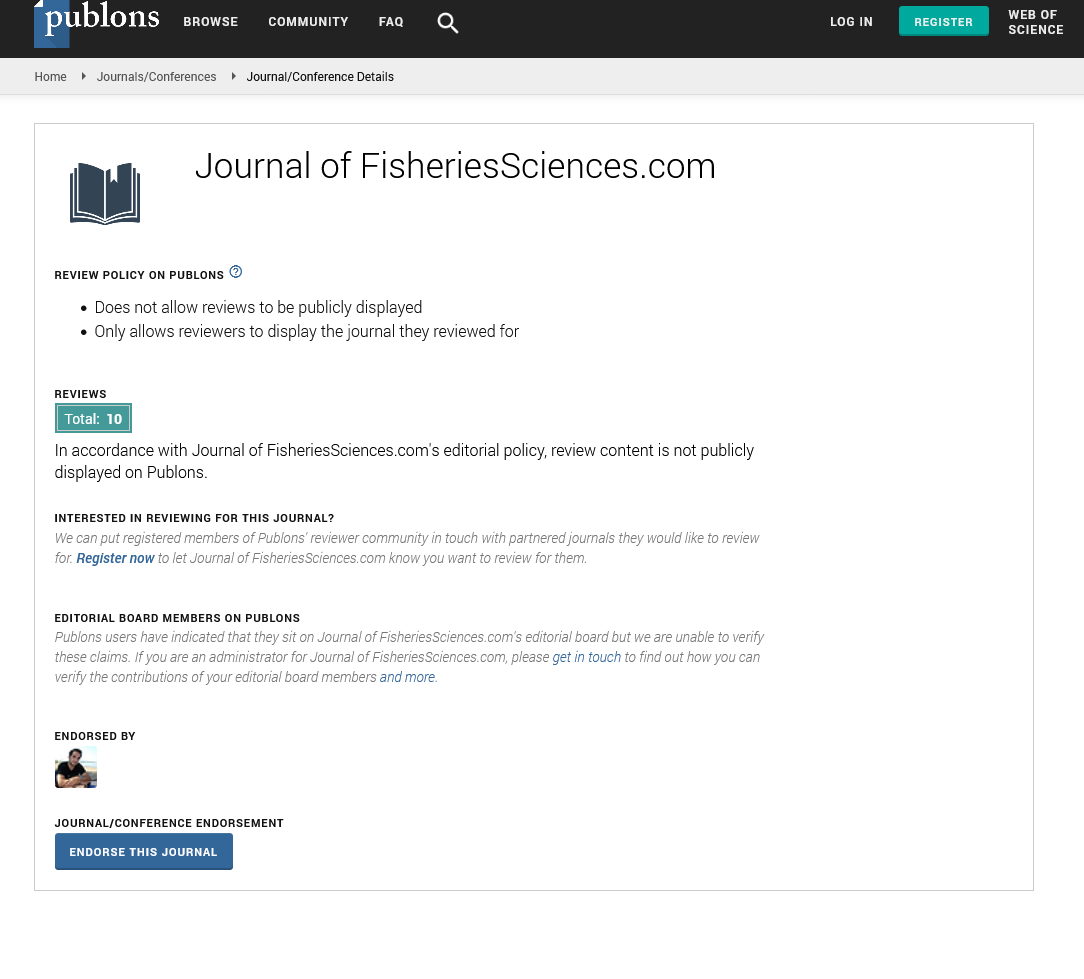Perspective - (2024) Volume 18, Issue 6
Fisheries Management: Balancing Ecosystems and Economies
Ines Lehmann*
Department of Biology and Ecology of Fishes, University of AquaMed, Berlin, Germany
*Correspondence:
Ines Lehmann, Department of Biology and Ecology of Fishes, University of AquaMed, Berlin,
Germany,
Email:
Received: 03-Dec-2024, Manuscript No. IPFS-24-15410;
Editor assigned: 06-Dec-2024, Pre QC No. IPFS-24-15410 (PQ);
Reviewed: 20-Dec-2024, QC No. IPFS-24-15410;
Revised: 23-Dec-2024, Manuscript No. IPFS-24-15410 (R);
Published:
31-Dec-2024
Introduction
Fisheries management is a critical aspect of preserving aquatic
ecosystems and ensuring the sustainability of fish populations.
Effective management strategies are essential for balancing
ecological health with economic needs, especially as global
demand for seafood continues to rise. This article explores the
principles of fisheries management, the challenges faced and the
strategies employed to promote sustainability.
Description
Understanding fisheries management
Fisheries management encompasses the policies, regulations
and practices designed to maintain healthy fish populations and
their habitats. The primary goals are to prevent overfishing,
protect marine and freshwater ecosystems and ensure that fish
populations remain viable for future generations. Successful
management requires a multidisciplinary approach, integrating
biological, ecological, economic and social considerations.
Key principles of fisheries management
Sustainability: The cornerstone of fisheries management is
sustainability. This principle ensures that fishing practices do not
deplete fish stocks beyond their capacity to recover. Sustainable
management involves setting quotas and regulations that allow
fish populations to reproduce and maintain healthy numbers.
Ecosystem approach: An ecosystem-based management
approach recognizes the interconnectedness of species and their
environments. Rather than focusing solely on individual ish
species, this approach considers the entire aquatic ecosystem,
including predators, prey and habitat conditions.
Adaptive management: Given the dynamic nature of aquatic
environments and fish populations, adaptive management is
crucial. This approach involves monitoring and adjusting
management strategies based on new data and changing
conditions. It allows for flexibility and responsiveness to
unforeseen challenges.
Precautionary principle: The precautionary principle advocates
for taking proactive measures to prevent environmental harm,
even in the face of scientific uncertainty. This principle is
particularly important in fisheries management, where over fishing and habitat degradation can have severe and irreversible
impacts.
Challenges in fisheries management
Overfishing: Overfishing remains one of the most significant
challenges in fisheries management. When fish are harvested at
a rate faster than they can reproduce, populations decline and
ecosystems become imbalanced. Overfishing can also lead to the
collapse of commercial fisheries, impacting economies and
livelihoods.
Bycatch: Bycatch refers to the unintentional capture of nontarget
species during fishing operations. This can include juvenile
fish, marine mammals and seabirds. Bycatch can have
detrimental effects on biodiversity and disrupt the balance of
marine ecosystems.
Habitat degradation: Human activities such as coastal
development, pollution and destructive fishing practices can lead
to habitat degradation. Healthy habitats, such as coral reefs,
seagrass beds and wetlands, are essential for the survival and
growth of fish species.
Climate change: Climate change affects fisheries by altering
ocean temperatures, sea levels and acidification. These changes
can impact fish migration patterns, reproductive cycles and the
availability of prey. Adapting management strategies to address
the effects of climate change is crucial for long-term
sustainability.
Strategies for effective fisheries management
Regulation and quotas: Establishing and enforcing fishing
quotas and regulations is a fundamental strategy in fisheries
management. Quotas set limits on the amount of fish that can
be harvested, ensuring that fishing pressure does not exceed
sustainable levels. Regulations may also include size limits,
seasonal closures and gear restrictions to protect vulnerable
species and habitats.
Marine Protected Areas (MPAs): MPAs are designated regions
where fishing activities are restricted or prohibited. These areas
serve as refuges for fish populations to recover and thrive. MPAs
can also help protect critical habitats and enhance biodiversity.
The design and management of MPAs require careful
consideration of ecological, economic and social factors.
Stock assessment: Regular stock assessments are essential for
understanding the status of fish populations and informing
management decisions. These assessments involve collecting
and analyzing data on fish abundance, growth rates and
reproductive success. Accurate stock assessments help set
appropriate quotas and manage fishing pressure effectively.
Community involvement: Engaging local communities and
stakeholders in fisheries management is vital for success.
Community-based management approaches recognize the
knowledge and experience of local fishers and involve them in
decision-making processes. This participatory approach fosters
cooperation and increases the likelihood of compliance with
regulations.
Conclusion
The deep sea, defined as the part of the ocean below 200
meters, is one of the least explored and most mysterious regions of our planet. It is home to unique and often bizarre life forms
adapted to extreme conditions such as high pressure, low
temperatures and complete darkness. Research in this area is
conducted using specialized equipment such as Remotely
Operated Vehicles (ROVs) and manned submersibles.
Deep-sea exploration has led to the discovery of remarkable
species, such as the giant squid and the bioluminescent
anglerfish. These creatures possess adaptations that allow them
to thrive in the harsh deep-sea environment. For example, the
anglerfish uses a bioluminescent lure to attract prey, while the
giant squid has large eyes adapted to see in the dark.
Citation: Lehmann I (2024) Fisheries Management: Balancing Ecosystems and Economies. J Fish Sci. Vol.18 No.6






